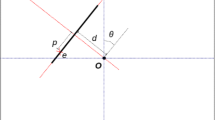Abstract
Corners and vertexes are strong and useful features in computer vision for scene analysis, stereo matching, and motion analysis. Here, we deal with the development of a computational approach to these important features. We consider first a corner model and study analytically its behavior once it has been smoothed using the well-known Gaussian filter. This allows us to clarify the behavior of some well-knowncornerness measure based approaches used to detect these points of interest. Most of these classical approaches appear to detect points that do not correspond to the exact position of the corner. A new scale-space based approach that combines useful properties from the Laplacian and Beaudet's measure (Beaudet 1978) is then proposed in order to correct and detect exactly the corner position. An extension of this approach is then developed to solve the problem of trihedral vertex characterization and detection. In particular, it is shown that a trihedral vertex has two elliptic maxima on extremal contrast surfaces if the contrast is sufficient, and this allows us to classify trihedral vertexes in 2 classes: “vertex,” and “vertex as corner.” The corner-detection approach developed is applied to accurately detect trihedral vertexes using an additional test in order to make a distinction between trihedral vertexes and corners. Many experiments have been carried out using noisy synthetic data and real images containing corners and vertexes. Most of the promising results obtained are used to illustrate the experimental section of this paper.
Similar content being viewed by others
References
Asada, H., and Brady, M., 1986. The curvature primal sketch,IEEE Trans. Patt. Anal. Intell. Mach. 8:2–14.
Barnard, S.T., and Thompson, W.B., 1980. Disparity analysis of images,IEEE Trans. Patt. Anal. Mach. Intell. 2(4):333–340, July.
Beaudet, P.R., 1978. Rotational invariant image operators,4th Intern. Conf. Patt. Recog., Tokyo, pp. 579–583.
Bergholm, F., 1987. Edge focusing,IEEE Trans. Patt. Anal. Mach. Intell. 9(6):726–741.
Berzins, V., 1984. Accuracy of Laplacian edge detectors,Comput. Vis., Graph. Image Process., 27:195–210.
Beymer, D.J., 1989. Junctions: Their detection and use for grouping in images. Master of Science, MIT, May, 177 pages.
Canny, J.F., 1986. A computational approach to edge detection,IEEE Trans. Patt. Anal. Mach. Intell. 8(6):679–698.
Deriche, R., 1987. Using Canny's Criteria to Derive a Recursively Implemented Optimal Edge Detector,Intern. J. Comput. Vis. 1:167–187.
Deriche, R., and Faugeras, O.D., 1990. 2-D curve matching using high curvature points: Application to stereo vision,Proc. 10th Intern. Conf. Patt. Recog., Atlantic City, June, pp. 240–242.
Deriche, R., and Giraudon, G., 1990. Accurate corner detection: An analytical study.Proc. 3rd Intern. Conf. Comput. Vis., Osaka, December, pp. 66–70.
Dreschler, L, and Nagel, H.H., 1982. On the selection of critical points and local curvature extrema of region boundaries for in-terframe matching,Intern. Conf. Patt. Recog., pp. 542–544.
Dreschler, L., and Nagel, H.H., 1982b. Volumetric model and 3D trajectory of a moving car derived from monocular TV frame sequences of a street scene,Comput. Graph. Image Process. 20:199–228.
Giraudon, G., and Deriche, R., 1991. On corner and vertex detection,Proc. Conf. Comput. Vis. Patt. Recog., Hawaii, Maui, 3–6 June, pp. 650–655.
Guiducci, A., 1988. Corner characterization by differential geometry techniques,Pattern Recognition Letters 8:311–318.
Harris, C., 1987. Determination of ego-motion from matched points,Proc. Alvey Vis. Conf., Cambridge, UK.
Harris, C., and Stephens, M., 1988. A combined corner and edge detector,Proc. 4th Alvey Vis. Conf., Manchester, August, pp. 189–192.
Horaud, R., Veillon, F., and Skordas, T., 1990. Finding geometric and relational structures in an image,Proc. 1st Europ. Conf. Comput. Vis. Antibes, France, April, pp. 374–384.
Hua, H.Z., and Quian, Y., 1986. A direct corner detection algorithm,Proc. 8th Intern. Conf. Patt. Recog., October, Paris, pp. 853–855.
Kitchen, L., and Rosenfeld, A., 1982. Gray-level corner detection,Patt. Recog. Lett., 1:95–102, December.
Krueger, W.M., and Phillips, K., 1989. The geometry of differential operators with application to image processing, IEEE Trans. Patt. Anal. Mach. Intell. 11:1252–1264, December.
Lipschutz, M.M., 1969.Differential Geometry. McGraw-Hill: New York.
Marr, D., and Hildreth, E., 1980. Theory of edge detection,Proc. Roy Soc. London B207:187–217.
Medioni, G., and Yasumuto, Y., 1986. Corner detection and curve representation using cubic B-spline,IEEE Intern. Conf. Robot. Autom. San Francisco, pp. 764–769.
DeMicheli, E., Caprile, B., Ottonello, P., Torre, V., 1989. Localization and noise in edge detection,IEEE Trans. Patt. Anal. Mach. Intell. 11(10):1106–1117.
Mokhtarian, F., and Mackworth, A., 1986. Scale-based description and recognition of planar curves and 2D shapes,IEEE Trans. Patt. Anal. Mach. Intell. 8(1):34–43.
Moravec, H.P., 1977. Towards automatic visual obstacle avoidance,Proc. 5th Intern. Joint Conf. Artif. Intell., Cambridge, MA, USA, August, p. 584.
Nagel, H.H., 1983a. Displacement vectors derived from second-order intensity variations in image sequences,Comput. Vis. Graph., Image Process. 21:85–117.
Nagel, H.H., 1983b. Constraints for the estimation of displacement vector fields from image sequences,Intern. Joint Conf. Artif. Intell, Karlsruhe, pp. 156–160.
Nagel, H.H., 1987. On the estimation of optical flow: relations between different approaches and some new results,Artificial Intelligence 33:299–324.
Noble, J.A., 1988. Finding corners,Image Vis. Comput. 6:121–128.
Rangarajan, K., Shah, M., and Brackle, D.V., 1989. Optimal corner detector,Comput. Vis., Graph. Image Process. 48:230–245.
Rohr, K., 1990. Uber die Modellierung and Identifikation charakteristischer Grauwertverlaufe in Realweltbildern,DAGM Symposium Mustererkennung 1990, 24–26 Sept. pp. 217–224.
Shah, M.A., and Jain, R., 1984. Detecting time-varying corners,Comput. Vis. Graph. Image Process 28:345–355.
Singh, A., and Shneier, M., 1990. Grey level corner detection: A generalization and a robust real time implementation,Comput. Vis. Graph. Image Process. 51:54–69.
Torre, V., and Poggio, T.A., 1986. On edge detection,IEEE Trans. Patt. Anal. Mach. Intell. 8(2):147–163.
Zuniga, O.A., and Haralick, R.M., 1983. Corner detection using the facet model,Proc. Conf. Patt. Recog. Image Process. pp. 30–37.
Author information
Authors and Affiliations
Rights and permissions
About this article
Cite this article
Deriche, R., Giraudon, G. A computational approach for corner and vertex detection. Int J Comput Vision 10, 101–124 (1993). https://doi.org/10.1007/BF01420733
Received:
Revised:
Issue Date:
DOI: https://doi.org/10.1007/BF01420733




